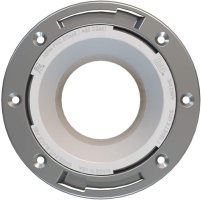Lee_Leses
Member
I've been watching this flange for quite some time, it mostly has not been leaking.
I know 95% the problem is a bad cement joint between the PVC flange and the PVC 90 that it's connected to.
I'm very dubious of any of the easy to use rubber kits / boots that promise to seal the leak.
It now occurs to me that basically what I need is a new flange installed.
What's the best way to do that? I'm thinking the best way most done is to cut the PVC pipe off and assemble a new PVC flange using a coupler to splice the PVC pipe?
Are the Oakey flange's with metal rings more desirable than the flanges that are all PVC?
Lastly, is replacing a flange best done from upstairs cutting in to the floor with tiles, or downstairs cutting in to the ceiling? Is either recognized as a better method, or is every situation different?
Also, my opinion is that the tapered flange w/o the test cap (see pic) is by far a better choice, it lets the wax seal do it's sealing more reliably, I think.
I know 95% the problem is a bad cement joint between the PVC flange and the PVC 90 that it's connected to.
I'm very dubious of any of the easy to use rubber kits / boots that promise to seal the leak.
It now occurs to me that basically what I need is a new flange installed.
What's the best way to do that? I'm thinking the best way most done is to cut the PVC pipe off and assemble a new PVC flange using a coupler to splice the PVC pipe?
Are the Oakey flange's with metal rings more desirable than the flanges that are all PVC?
Lastly, is replacing a flange best done from upstairs cutting in to the floor with tiles, or downstairs cutting in to the ceiling? Is either recognized as a better method, or is every situation different?
Also, my opinion is that the tapered flange w/o the test cap (see pic) is by far a better choice, it lets the wax seal do it's sealing more reliably, I think.
Attachments
Last edited:

